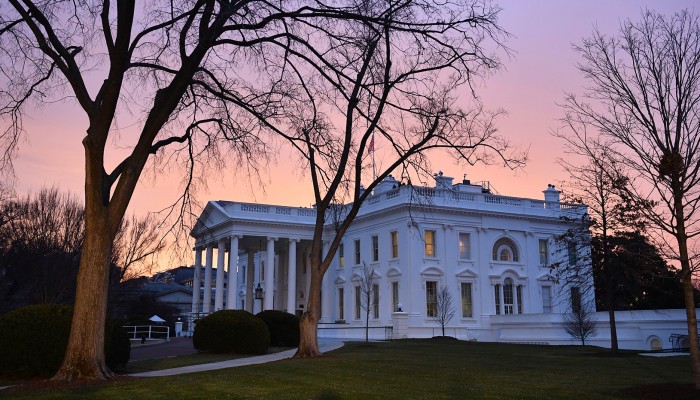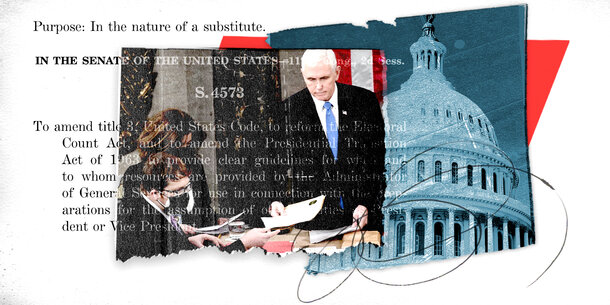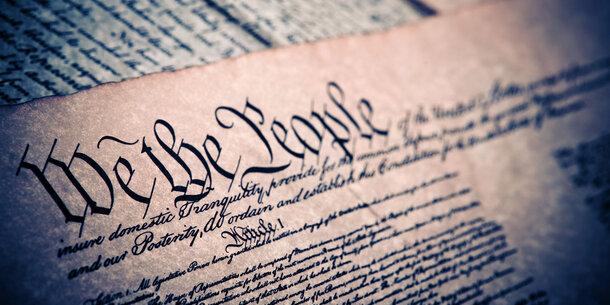UPDATE: On July 6, the Supreme Court unanimously ruled, “A State may enforce an elector’s pledge to support his party’s nominee—and the state voters’ choice—for President. … Electors are not free agents; they are to vote for the candidate whom the State’s voters have chosen.”
Every presidential election brings renewed debate about the Electoral College. The discussion resonates even more this year, since Donald Trump won the presidency in 2016 despite losing the popular vote by nearly 3 million.
Most of the Democratic presidential candidates want to abolish the Electoral College to ensure the person with the most votes always wins. Changing to direct election of the president could be accomplished through a constitutional amendment or, less permanently, a method such as the National Popular Vote Compact, an agreement among states to award their electoral votes to the candidate who wins the national popular vote. Before his election, Trump called the current system a “disaster,” but afterwards, he said that “the Electoral College is far better for the U.S.A.”
The Supreme Court may soon weigh in on a key aspect of how the system works. In a pair of court rulings that have been appealed to the high court, the justices are being asked to decide whether states can require presidential electors to vote for that state’s popular-vote winner.
The Electoral College cases
In Washington State in 2016, three so-called “faithless” electors voted for Colin Powell instead of Hillary Clinton, violating a pledge under state law to vote for the candidate who won the most votes in their state. The state fined them for their defiance, and in May 2019, the Washington Supreme Court upheld the fines, ruling that the Constitution gives the state power to impose a financial penalty on electors who violate their pledge.
In Colorado, a Democratic elector also violated his pledge to vote for Clinton, the candidate chosen by the voters in that state. Colorado’s secretary of state removed the elector from his post and replaced him with someone who proceeded to vote for Clinton. In this case, the U.S. Court of Appeals for the Tenth Circuit ruled against the state, holding that it lacked constitutional authority to remove and replace faithless electors.
The losing sides in both lawsuits have petitioned the Supreme Court to take their case, potentially setting the stage for the first major decision on the way we choose the president since Bush v. Gore, which halted the Florida recount in 2000 and delivered the White House to George W. Bush.
Choosing electors in theory and practice
The Constitution never specifically mentions the Electoral College. It is, in fact, a colloquial term for the process by which the president and vice president are chosen. The constitutional rules that govern their selection are found in Article II and the Twelfth and Twenty-Third Amendments.
Under Article II, each state is afforded a number of electors equal to the size of its congressional delegation, that is, the number of representatives plus its two senators. (The Twenty-Third Amendment added three electors from the District of Columbia.) The Twelfth Amendment, which was ratified in 1804, outlines the procedures for the electoral system we still use today. The electors meet in their home states to cast votes on separate ballots for the president and vice president. They then deliver their votes to Congress to be counted in what has become a mostly ceremonial proceeding. Importantly for the purposes of these recent cases, states can appoint their electors “in such manner as the Legislature thereof may direct.”
While the Constitution is clear that states have discretion on how they choose their electors, it leaves open whether they may instruct the electors how to vote and, if so, whether they may enforce those instructions. As it was originally conceived, the Electoral College was supposed to consist of a fleeting body of men (they were only men at the time) “most likely to possess the information and discernment requisite” to select the president. They were to exercise sober deliberation and be afforded some measure of independence in their task.
But two things separated the theory from the practice. One was the rise of the party system. When partisans chose electors, it became clear that those electors would forgo their discretion and vote for their party’s candidate. The other was the change in how electors were selected. Early on, electors were chosen in a variety of methods: some were elected by district and some were appointed by their state legislatures. However, by the middle of the nineteenth century, as many states loosened their suffrage requirements, most enacted laws giving the voters the power to choose their states’ electors through popular election. For the most part, electors have loyally voted for their party’s nominee, defecting only rarely.
In 1952, the Supreme Court ruled that state parties can require electors to pledge to vote for their parties’ nominee before they are certified as electors. The dispute arose out of the “Dixiecrat Revolt” that led to Strom Thurmond’s 1948 presidential bid under the States’ Rights Party, which siphoned 39 electoral votes from President Harry S. Truman, the party’s nominee.
Justice Robert Jackson, in a blistering dissent, wrote:
“The demise of the whole electoral system would not impress me as a disaster. At its best, it is a mystifying and distorting factor in presidential elections which may resolve a popular defeat into an electoral victory. At its worst, it is open to local corruption and manipulation, once so flagrant as to threaten the stability of the country. To abolish it and substitute direct election of the President, so that every vote, wherever cast, would have equal weight in calculating the result, would seem to me a gain for simplicity and integrity of our governmental processes.”
Notably, the Court did not address whether the required pledges were legally enforceable, which brings us to today.
So who are these electors now?
In the Washington case, In re Guerra, the state’s supreme court ruled that the electors’ pledges to vote for the candidate of their party were enforceable. However, the federal appeals court in Denver ruled that they are not, rejecting the “argument that the power to appoint electors necessarily includes the power to remove them and to cancel an already-cast vote.” That court noted that the Constitution was silent on the question and interpreted that silence to mean that states lack the power to remove electors.
So, who are these electors?
In general, they are, as Jackson called them, “party lackeys.” In most states, they are selected at political conventions by the state party committee or by members of party leadership. They are chosen over a wide timespan, from early in the presidential election year to just weeks before the contest, though most are selected during the summer. And while their names may or may not appear on the ballot, they are the people you vote for when you cast your vote for president.
Electors vote as expected about 99 percent of the time. Over the last century, just 19 electors bucked the system to vote their conscience. Remarkably, 10 did so (or attempted to do so) in 2016. Faithless electors have never changed the outcome of an election, though in 1836, they threw the vice-presidential election of Richard Johnson to a contingent election in the Senate after Virginia’s electors refused to vote for him due to his relationship with Julia Chinn, an enslaved person. (Under the Constitution, if a vice-presidential candidate does not receive a majority in the Electoral College, then the Senate decides the winner.)
While party loyalty largely explains the low rate of defection, state legislation provides additional incentive for electors to vote for their party’s nominee.
Thirty-two states and the District of Columbia have laws that “bind” electors to vote according to their pledge. Nineteen of those states and the District of Columbia have no legal consequences for electors who defy the will of the voters. In 11 states, a non-compliant vote is nullified, the office is presumed vacant, and a new elector is chosen. (Colorado is not among this group but interpreted its law in this way.) And in four others, including two that also replace faithless electors, violating the pledge is punishable by prosecution or a fine.
But before 2016, no elector had ever been subjected to a penalty or replacement.
The cracks in the electoral college
Now, the Washington electors and the Colorado secretary of state have asked the U.S. Supreme Court to hear their cases. If the justices deny the requests outright, the Tenth Circuit Court of Appeals decision would remain in effect, invalidating the full spectrum of elector laws in Colorado and five other states. (While the ruling in Washington would also stand, recent changes in the state’s law would limit its immediate practical impact.)
If the Supreme Court takes the cases, three options stand out: the justices can rule that states have the power to sanction and remove faithless electors to enforce the will of the voters; they can rule that states have the power to sanction but not to remove them; or they can rule that states have neither power, freeing electors to exercise discretion.
The faithless elector cases have exposed more cracks in the anachronistic Electoral College system. The justices can deny the existence of cracks, allow them to expand and become faults, or try to “patch” them yet again. Whatever the outcome, the cases provide yet one more reason why the country should adopt a fairer system that counts every person’s vote equally.






